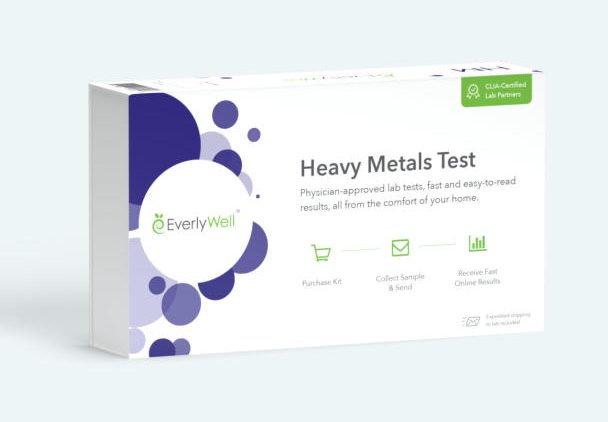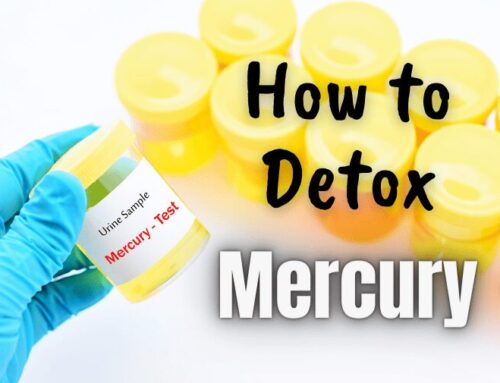Sick of Being Stuck is reader-supported. When you buy through links on my site, I may earn a commission. Disclosure.

These can all be signs of copper toxicity and adding the wrong medication to the wrong problem can only make it worse. Understanding healthy copper levels and copper detox methods is an important step to take control of your physical and mental health.
We will first help you to understand how to identify copper toxicity in you or your loved ones. Next, we will also give you safe copper detox methods to prevent further damage and reduce dangerous levels of copper in the body.
Want to not just think, but know for sure, and be able to treat your body correctly? Then order an at-home heavy metal test today and finally know what’s going on!
What is Copper Toxicity?
Copper has an important purpose in the body, but any type of copper imbalance can disrupt major functioning in the human body.
- Healthy Copper Levels: Every human being has between 50-80 milligrams of copper in their body during their life. At healthy levels, copper plays an important role in your overall health.
- Copper is helping you to create bone, ligament, and connective tissue. This is important for strengthening your bones and preventing osteoporosis and scoliosis.
- Copper also helps with delivering cellular energy, which is why an imbalance can lead to fatigue and depression.
- Copper plays a major role in the nervous system and stimulates the production of neurotransmitters. A copper imbalance is often associated with psychological, emotional, and often neurological conditions including memory loss in young people, depression, anxiety, bipolar disorder, schizophrenia, and others.
- Copper Deficiency: Copper is found mostly in our diet, specifically in meats, eggs, poultry, nuts, seeds, and grains. Fruits, vegetables, and refined foods are low in copper. If you’re not eating the right foods, or if your body processes copper too quickly, you may be at risk for copper deficiency.
- Biounavailable Copper: This occurs when the copper in the body is not being used properly. It is basically copper gone rouge. Rather than being bound and transported to do its job, it roams freely in the body and accumulates in areas where it can’t be easily accessed. This accumulation can lead to copper toxicity in almost any organ or system of the body.
- Copper Poisoning: When copper reaches above-normal levels, (140 mcg/dL) your body has accumulated dangerous levels of copper and you are at risk for the devastating effects of copper poisoning. Both adults and children can experience copper poisoning if they’re food and environment are not handled properly.
What Causes Copper Poisoning?
There are several culprits that cause copper poisoning. Many of these sources are difficult to identify until the copper has already accumulated in the body and not detoxed.
- Water: Everyday drinking water can become contaminated by farms or industrial waste in nearby reservoirs or wells or simply by traveling through copper pipes.
- Food: Because most of our copper comes from food, consuming a lot of copper-rich foods with copper supplements can be too much of a good thing.
- Birth Control: Estrogen increases the retention of copper in the kidneys. This is why hormonal birth control may affect the absorption of copper properly in the body.
- Copper Pipes: Drinking water from copper pipes is one of the leading causes of copper toxicity.
- Stress: When you’re under a lot of stress, the adrenal glands are compromised, making it more difficult for them to transfer copper effectively.
- Zinc Deficiency: Zinc and Copper are a dream team that works together. Zinc binds to copper to carry it where it needs to go. If you’re low in zinc, you end up with rogue copper that accumulates in the body with nowhere to go.
- Mineral Imbalance: Copper also needs sufficient levels of Vitamin C, B complex, and other minerals like iron, selenium, chromium, etc. If your overall level of vitamins and minerals is low, copper can overcompensate to toxic levels.
- Adrenal Fatigue: Copper needs the adrenal glands to get to the mitochondria, but those same glands need copper for energy. This is a catch 22 which allows copper to accumulate rather than be used.
- Xenoestrogens: These are estrogen compounds found in the environment, mostly pesticides, plastics, and other chemicals. They can increase estrogen in the body and increase the retention of copper in the kidneys.
- Copper Cookware: Our food supplies healthy copper, but if we are using rusty copper pots, pans, cocktail shakers, or drinkware, that can increase levels. New copper is safer, but if your copper cookware is corroded, it should be disposed of.
- Inherited: If the mother has high levels of copper, it can be transferred to the baby in utero.
- Impaired Methylation: Methylation is one of the body’s natural copper detox pathways, when this is blocked or not functioning properly, all kinds of heavy metals can begin to accumulate in the body.
What are the Symptoms of Copper Toxicity?
While copper toxicity can cause a myriad of symptoms in the body, the strongest signs are those that affect the nerves and nervous system. Mood swings, depression, mental agitation, racing thoughts, restlessness, anxiety, insomnia, and mental exhaustion are hallmark signs of copper toxicity. Other symptoms may include:
|
|
What Disorders are Associated with Copper Toxicity?
Accumulation of copper can happen anywhere in the body, but it most frequently affects the four major systems of the body: nervous, reproductive, connective tissue, and the liver.
- Nervous System Disorders: When copper accumulates in the nervous system, it can have a profound effect on mental and emotional conditions. Possible disorders include moderate to suicidal depression, anxiety, violence, OCD, bipolar disorder, phobias, Tourette’s syndrome, schizophrenia, epilepsy, ADD, ADHD, autism, delayed mental or emotional development, panic attacks, migraines, spaciness, brain fog, mind racing, insomnia, nervousness, and irritability.
- Reproductive Disorders: This generally affects women, because women have higher levels of copper than men in most cases. Copper toxicity in the woman’s reproductive system includes increased PMS symptoms, amenorrhea, dysmenorrhea, fibroid tumors, ovarian cysts, pelvic inflammatory disease, fibrocystic breast disease, endometriosis, infertility, miscarriage, low libido and possibly pelvic inflammatory disease.
- Connective Tissue Disorders: Because copper is a major ingredient in collagen, too much copper in the body leads to connective tissue problems including arthritis, osteoporosis, stretch marks, joint problems, scoliosis, kyphosis (bad posture), and other poor skin, hair, and nail conditions.
- Liver Disorders: The liver is often the first place copper will accumulate. This can lead to A sluggish liver due to copper toxicity which causes slow metabolism, chronic infections, and hepatitis C.
How Do You Test for Copper in the Body?
Copper levels in the body can be detected with a blood test. If there are questions about the toxicity levels, your doctor may also request a urine test to measure how much copper is being filtered, and possibly a tissue biopsy of the liver to check for copper filtration issues.
Generally speaking, these tests will only be conducted if your doctor notices any symptoms of copper poisoning during a physical exam.
So in my opinion, I like to put my health in my own hands. That’s why I always take heavy metal tests like this one to figure out what I am being exposed to that is making me tired, moody, and overall not happy.
If you suspect copper poisoning, you may have to request these tests yourself. Don’t be shy to speak up for yourself.
HTMA, or Hair Test Mineral Analysis, is another way to test how much of a certain mineral your body has utilized. With this test, you simply clip some of your scalp hair at the base because this will show the most recent levels of your minerals. If you had a recent high exposure then you might see a high spike of copper on your test.
However, if you have had a slow accumulation over time (because of birth control, copper pipes, or diet) then you will notice the opposite. Your body is unable to rid the excess copper, so instead, you will see your body depleting the minerals that copper is taking up. Most notably, you will see unbalanced levels of calcium, magnesium, sodium, and potassium.
Imbalance with these four major minerals will also cause other issues which is why most, unfortunately, are not able to diagnose their symptoms to the root cause. This makes it even more important to make sure you focus on a copper detox to help subside any side effects you might be having from hidden copper toxicity.
How do you Detox Copper from the Body?
A proper detox will take at least 6 months and can take several years, depending on severity. Because of the minerals found in meat, it will take vegetarians significantly longer for a liver detox because they typically already have reduced adrenal and metabolic function.
I highly recommend using meat to your advantage by eating the highest quality you can find. Those nutrients are very vital to the process.
If you don’t have any locally, then check out the special offer they have at ButcherBox for 100% grass-fed beef, free-range organic chicken, pork raised crate-free, and wild-caught seafood
Copper Detox Protocol:
Step 1: Remove the source of copper
This includes removing a copper IUD like Paraguard if you have one and avoiding copper high foods. If your home or office has copper pipes, use bottled water for a while. Without removing the initial source (if you can identify it) will make it difficult to ever fully recover. If your water is compromised, then consider getting a solid water filter.
If you suspect your water may be compromised, then read my reviews of the best heavy metal water filters.
Step 2: Open detox pathways
Next, you want to make it really easy for the excess copper to exit the premises with regular bowel movements. This is a vital step to introduce before you start attacking the copper and making it move more around your system. In order to do this, increase bile production with Taurine, Dr. Shade’s Bitters No.9, and support the liver with Bioray Liver Life, milk thistle, Phos-Choline, and Lithium Orotate.
Step 3: Build support
Before you start the process of actively removing the copper, you want to ensure you are building support in other body systems. Balance your body minerals with Phytoplankton. It is one of the best natural ways to get calcium, magnesium, sodium, and potassium in balance and happy. Also, support adrenals with an adrenal cocktail, which is high in vitamin C to help with copper detox.
Step 4: Active Detox
Begin by mobilizing heavy metals with Biosil. Take for 2-3 days before adding in binders like Pectasol-C, and Zeolite that will attach to the copper and lead it to the exit. Next, detox copper from the blood with Seeking Health Molybdenum. You can use Zinc Glycinate as well but beware this can create more sudden and sometimes overwhelming detox side effects.
If the supplement is too strong, you can eat other mineral-rich foods high in zinc, magnesium, and sodium. My best suggestions would be cilantro, Beef, Buffalo, Lamb, Chicken, Venison, Eggs, and Pumpkin seeds. And seriously, check out ButcherBox. It has made my health journey so much easier.
Additional Tips for Copper Detox:
- Use a Sauna: The infrared rays of regular sauna use can help expedite the detox process by sweating out heavy metals through the skin. Using a sauna in connection with diet and supplements can be an effective copper detox method. Learn more about how to use a sauna properly and the additional health benefits of regular sauna use.
- Drink lots of clean water: Water is a key component to any detox, but when it comes to copper detox choose your water carefully. If the copper is coming from your pipes, and you drink a lot of water to detox, you’re only making it worse. Ensure you’re drinking only clean water by using a heavy metal water filter. The best would be any of the Berkey Filter products. I own the Big Berkey and love it!
- Coffee Enemas – You can purchase coffee enemas or make your own at home with straight organic ground coffee and an at-home enema kit. Coffee enemas help support the production of bile and stimulate your gallbladder to help your liver push out the bad stuff out the other end.
- They sound scary, but they aren’t! Check out the complete guide to Coffee Enemas here.
- Gentle physical exercise: During your detox, you may feel weak and tired. There’s no need to exercise excessively, but a nice walk or jog can do wonders to keep your body moving and aid in the copper detox process. Walking especially can help get your lymph system moving. For more information on cleansing your lymph system read here.
- Meditate and calm down! Because copper can exacerbate the “flight or fight” response in the body, it’s important to take stress relief seriously during your copper detox. Find reliable meditation methods and take action to reduce your stress.
What will I experience during the copper cleanse?
Slow and steady wins the race when it comes to copper detox. A copper detox requires the body to mobilize the copper into the bloodstream for transportation to the liver and kidneys to remove it from the body. Because the copper is moving throughout the body, symptoms of detox often mirror those of copper toxicity. Detoxing too quickly can make these symptoms worse.
Copper Dumping
Zinc and copper go hand-in-hand in the body. If you increase the levels of zinc through supplements, it causes copper to dump into the bloodstream. When this happens, you can experience terrible side effects including swelling, joint pain, brain fog, tremors, migraines, nausea, IBS, ulcerative colitis, and neuroinflammation.
“It is vital to be aware that although copper toxicity and its accompanying symptoms can be highly debilitating, it is equally important to be careful not to bring the levels down too low or to cause zinc to go too high, as this can be just as detrimental to one’s physical, emotional, and spiritual health. Remember that balance is the key,” said Cynthia Perkins from Holistic Help.
I highly recommend making sure that you are having bowel movement regularly and empyting completely. If daily, consistent poops are not something you are blessed with, then add this supplement to your morning drink to complete the detox process.
Other Copper Detox Symptoms
- Headaches, racing thoughts, mood swings, and energy fluctuations are common when copper is in the bloodstream.
- Testicular pain in men and changes in menstruation.
- Skin changes including acne and rashes.
- Nausea or impaired appetite.
- Candida initial buildup often goes away on its own with the copper.
- Irritability, nervousness, anxiety, brain fog, spaciness, depression, weepiness, and/or emotional sensitivity.
These symptoms of copper detox are temporary and will gradually lessen and then completely disappear as the copper level decreases and your body begins to function better.
Benefits of Detoxing
Copper detox is not a fun or quick process, but it is well worth it. Without eliminating the excess copper in your body, you’ll never be free from the side effects you’ve been living with. Once your body is back to normal copper levels, it’s like being granted a whole new life experience including:
- Stronger immunity and lower chance of infections and disease, including cancer.
- Healthy mental and emotional functioning.
- Regular and better periods with less tendency for endometriosis, ovarian and uterine tumors.
- Increased energy
- Healthy skin, hair, and nails.
- Less risk of liver, heart, and artery disease.
- Reduced chance of postpartum depression, morning sickness, and problems in pregnancy and birth defects.
Let’s Get Clean
Copper is an essential element that is perfectly safe and healthy at low levels. It helps maintain a healthy metabolism, promotes strong and healthy bones, and ensures your nervous system works properly.
We get most of our copper from our everyday diet. Excess copper hitches a ride on the body’s natural detox system and is excreted through waste. When copper levels get too high, this causes symptoms that can affect your quality of life.
While a complete detox can take several months, or possibly years to complete, using a copper detox program is worth the temporary discomfort to achieve and maintain excellent mental and physical health.










Do you ever answer any questions regarding the protocol you have suggested for taking the supplements to reduce copper levels in the body? I need some suggestions about when to take some of the supplements you have listed. I have had insomnia for the past 8 years. If there are supplements that would be helpful for my sleep, I would like to know if I should take them at bedtime etc.
Thanks so much for posting this information when it is lacking in much of the medical literature! I need this information!
I am not a medical professional, so I suggest that you talk to your doctor or find a local holistic practitioner. From my experience, the best natural treatment would be to incorporate magnesium and even CBD (if you are open to it) starting when you begin the protocol. I take both a few hours before bed and they have helped me tremendously. But it sounds like you may be needing to detox more than just copper… and don’t despair because most of us have more than one issue going on. Take care!
Brittany,
Thanks for very much needed info regarding copper toxicity.
What is your opinion on the Pink Himalayan Salt baths?
My functional medicine doc recommended these 3 times a week as these work on a basis of ion exvhange.
Thanks,
Jacek
Hi Jacek! I think the salt baths are a great addition. There is a lot the body is going through and simple weekly actions like that can really aid the process of the body’s recovery! Thanks for stopping by and good luck!